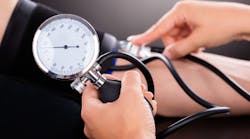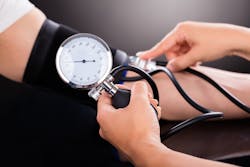Updated guidelines for blood pressure: Vital signs are still vital
In November of 2017, new clinical guidelines for the prevention, detection, and management of hypertension were released by the American College of Cardiologists (ACC) and the American Heart Association (AHA). (1) Historically referred to as "the silent killer," hypertension in the United States affects 85.7 million adults, 34.0% of whom are more than 20 years of age. (2) Also in 2017, the American Academy of Pediatrics released new guidelines for diagnosing hypertension among youths. (3) Under the new guidelines, approximately 800,000 more youths are classified as having hypertension. (4)
Prior to the changes, a systolic reading of 120–139mm Hg or a diastolic reading of 80–89 mm Hg qualified an individual as having prehypertension. However, as shown in Table 1, the 2017 guidelines eliminate the prehypertension category altogether. Instead, the 2017 guidelines designate an individual with both a systolic measurement of 120–129 mm Hg and a diastolic pressure of under 80 mm Hg as having "elevated" blood pressure. Additionally, hypertension is now assigned if an individual has a systolic reading of 130 mm Hg or higher or a diastolic reading of 80 mm Hg or higher. Given these new parameters, dental professionals will likely see even more patients whose blood pressure readings are in the category of hypertension.
Table 1: 2017 categories of blood pressure in adults
Adapted from American College of Cardiology and American Heart Association Task Force on Clinical Practice Guidelines. (1)
The role of the dental hygienist: Theory vs. practice
During their professional educations, dental hygienists learn the components of the acronym ADPIE, which are as follows:
- assessment
- dental hygiene diagnosis
- planning for dental hygiene care
- implementation of the care plan
- evaluation of the care rendered
As part of the assessment phase, much time is dedicated in dental hygiene curricula for training students to evaluate and record vital signs—including blood pressure. Students must show competency in recording vital signs in order to successfully complete their clinical courses. Concurrently, the Standards for Clinical Dental Hygiene Practice of the American Dental Hygienists’ Association include the collection of vital signs, which include temperature, pulse, respiration, and blood pressure, as a necessary component of establishing the health history. (5)
However, in both research projects and anecdotally, dental hygienists frequently report that in their postgraduate settings they do not take or record blood pressures of patients. (6,7) Lack of time and a lack of value of the procedure by their dentists are commonly cited as reasons why this procedure is not performed.
Blood pressure and oral-systemic link
Frequent associations between systemic diseases and oral diseases have led to the common use of the term "oral-systemic link." Scientific reports and continuing education courses are filled with evidence that the health of the mouth affects the health of the body. Patients are becoming more aware of the need to seek dental care as a part of their overall health care. As professional health-care providers, dental hygienists are in a unique position to initiate the oral-systemic link conversation in the dental office. What better starting point for these conversations than taking the patient’s blood pressure?
A call to action
Due to the new blood pressure guidelines, more patients will be diagnosed with hypertension. And it can be reasonably assumed that a greater number of undiagnosed cases of hypertension will be present in the dental office patient population. This should be a call to action for the profession of dental hygiene. Dental hygienists must find ways to include this procedure in the assessment phase of the appointment. Vital signs are still vital!
Traditionally, dental hygienists have learned to assess blood pressure via the auscultatory method—using a stethoscope and a sphygmomanometer (figure 1). This manual method is the technique included in the ACC/AHA 2017 guidelines. (1) Unfortunately some hygienists do not feel competent in their skill with this technique. (6) If the lack of confidence with the procedure is added to a perceived lack of time for assessment, hygienists might easily justify neglecting an activity that was considered vital during clinical education.
Figure 1: Accurately measuring blood pressure
Prepare the patient
- Have the patient relax with feet on the floor.
- Do not talk during the measurement.
- Remove clothing covering location of cuff placement.
Use proper technique
- Use a validated, calibrated device with appropriately sized cuff.
- Support the patient’s arm during measurement.
Average the measurements
- Take an average of 2-3 readings on 2-3 separate visits to minimize errors.
Provide readings
- Provide verbal and written blood pressure readings for the patient.
Adapted from American College of Cardiology/American Heart Association Task Force on Clinical Practice Guidelines1
While the traditional manual method of blood pressure assessment was used in the 2017 Guidelines, some researchers believe a calibrated electronic device is preferable for recording blood pressure. (8) The use of an automated device could alleviate the lack of confidence in taking blood pressure by the clinician. Additionally, the procedure could be performed by another member of the dental team or even while the patient relaxes in the dental office reception room.
The medical community has long embraced the concept of community screening and monitoring of high blood pressure. Programs for screening in churches, synagogues, and even barbershops have shown success with identifying, monitoring, and even helping to lower blood pressure readings. (9,10) Community pharmacists are joining the effort to identify and treat high blood pressure. (11) Because many patients seek dental care more frequently than medical care, dental hygienists are in an ideal position to screen for elevated blood pressure readings and to steer patients to a physician’s office.
Drivers of patient health
In Clinical Practice of the Dental Hygienist, Esther Wilkins provides a definition of "profession" that includes the following: "[an] occupation or calling that: requires specialized knowledge, methods, and skills; requires preparation from an institution of higher learning [...] maintains high standards of achievement and conduct." (12) Dental hygienists—as professionals—are ethically bound to utilize their specialized knowledge and skills and to maintain the high standards of conduct they learned during their dental hygiene education. It’s time for the hygienist to go "from being a passive observer to instead becoming a driver of patient health." (13) It’s time to put vital signs back into practice.
RELATED:
10 reasons why we must take patients' blood pressure
Dental professional update: Blood pressure guidelines changed
References
1. Whelton PK, Carey RM, Aronow WS, et al. 2017 ACC/AHA/AAPA/ABC/ACPM/AGS/APhA/ASH/ASPC/NMA/PCNA guideline for the prevention, detection, evaluation, and management of high blood pressure in adults: a report of the American College of Cardiology/American Heart Association Task Force on Clinical Practice Guidelines. Hypertension. 2018;71:e13-e115.
2. Benjamin, EJ. Heart Disease and Stroke Statistics—2018 Update. Circulation. 2018;137:e67-e492.
3. Flynn JT, Kaelber DC, Baker-Smith CM, et al. Clinical Practice Guideline for Screening and Management of High Blood Pressure in Children and Adolescents. Pediatrics. 2017;140(3):e20171904.
4. Jackson SL, Zhang Z, Wiltz JL, et al. Hypertension Among Youths-United States, 2001-2016. MMWR Morb Mortal Wkly Rep. 2018;67:758-762.
5. Standards for Clinical Dental Hygiene Practice. American Dental Hygienists’ Association, 2016. https://www.adha.org/resources-docs/2016-Revised-Standards-for-Clinical-Dental-Hygiene-Practice.pdf. Accessed July 16, 2018.
6. Hughes C, Thompson A, Browning W. Blood Pressure Screening Practices of a Group of Dental Hygienists. J Dent Hyg. 2004;78(4).
7. Hughes C, Thompson A, Collins, M. Blood Pressure Assessment Practices of Dental Hygienists. J Contemp Dent Pract. 2006;(7)2:055-062.
8. Stergiou G, et al. Blood Pressure Measurement and Hypertension Diagnosis in the 2017 US Guidelines: First Things First. Hypertension. 2018;71:963-965.
9. Churches as an Avenue to High Blood Pressure Control. US Department of Health and Human Services National Blood Pressure Education Program. NIH Publication No. 87-2725; 1987.
10. Kuehn BM, Barbershop-Based Care Dramatically Trims Blood Pressure. Circulation. 2018;137:1861-1862.
11. Wilkins EM. Clinical Practice of the Dental Hygienist, 12th edition. Philadelphia, PA: Wolters Kluwer; 2017:(5).
12. Dixon DL, Salgado TM, Caldas LM, et al. The 2017 American College of Cardiology/American Heart Association hypertension guideline and opportunities for community pharmacists. J Am Pharm Assoc. 2018;(4)58:382-386. http://circ.ahajournals.org/content/137/17/1861 Accessed July 16, 2018.
13. News Article Friends of Hu-Friedy. How Hygienists Can Find Their Voice in Interdisciplinary Collaboration. https://friendsofhu-friedy.force.com. Accessed July 18, 2018.
Cynthia Hughes is an associate professor of dental hygiene at Augusta University, teaching in both the bachelor of science and degree completion programs. A past president of the Georgia Dental Hygienists’ Association, she has presented at regional and national meetings and also directs a clinical refresher course for dental hygienists who wish to return to practice. For more information, email her at [email protected].

